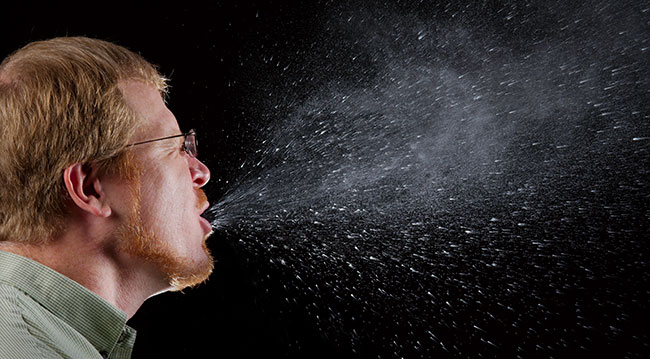Protecting your family against disease is crucial. Sneezing releases airborne pathogens that can include the common cold, influenza, measles and tuberculosis. Beyond infectious diseases, everywhere that people gather in America is festering with pathogens.

Sneezing releases airborne pathogens that can rapidly infect others
For example, in public restrooms, tests show that faucet handles are festering with E. Coli. At home, faucet handles are equally problematic, along with cutting boards, coffee makers, toothbrush holders and children’s toys.
Fortunately, there are solutions. If you are serious about keeping your home as clean and sterile as possible, this guide reviews a variety of disinfection solutions for kitchens, bathrooms, counter tops and even baby bottles.
Table of Contents
Dirtiest places in the home
This study about contaminated areas in the home found these household germs as the most likely to cause illness:
- Staphylococcus aureus (staph)
- Salmonella
- Fecal matter
- Escherichia coli (E. coli)
Pathogens spread differently throughout the house, as summarized below:
- Kitchen: a study done by the National Sanitation Foundation found that the kitchen far outranks the bathroom as the place with the most germs. When swabbing for coliform bacteria (which includes salmonella and E. coli), they found traces on 75% of dish rags, 45% of kitchen sinks, 32% of counter tops and 18% on cutting boards.
- Bathroom: the bathroom ranks as the second dirtiest place in the home, with the toilet, toothbrush holders, faucet handles and towels the most contaminated areas.
- All rooms: light switches, TV remotes, fridge door handles and other devices touched by many should be sterilized regularly
FAQs about disinfecting your home
What’s the difference between sanitized, disinfected and sterilized?
- Sanitizing: this is the weakest antimicrobial treatment. Sanitizing decreases the amount of microbes on a surface, which reduces the number of pathogenic microbes.
- Disinfecting: this reduces the number of microbes to a greater degree, rendering pathogenic microbes too low to have any negative effect. This method is effective and safe is most cases.
- Sterilizing: when you need high-powered removal of all microbes, UV sterilizers will kill 100% of microbes on a treated area. At home, this method is most effective for treating things that go into the mouth (like baby bottle nipples and toothbrushes).
How to disinfect a house after an illness
- Wash all towels and bedroom linens in hot water using a high quality laundry detergent
- Disinfect all commonly touched surfaces like doorknobs, faucet handles, light switches and TV remotes.
- Replace your toothbrushes. Better yet, get a UV Sterilizing toothbrush holder (reviewed further down in this guide).
- Disinfect kitchen and bathroom counter tops. Wash used dish rags and replace used sponges.
- Get some fresh air into your house.
- Apply disinfectant spray generously on all cloth furniture.
- Apply a deep vacuum (such as with a central vacuum cleaning unit) and disinfect all non-carpeted areas.
Are UV sanitizers effective?
For decades, UV has been used for industrial disinfection. Fortunately, recent advancements have brought this technology to consumers with household devices that can sterilize everything from toothbrushes to cell phones.
A study by the American Journal of Infection Control found that a portable UV wand can kill 100% of surface bacteria with less than 5 seconds of exposure.
Best disinfectant sprays for homes
Flu viruses can live on surfaces for around 24 hours, while norovirus can survive for weeks. Thus, while regular use of disinfectants are ideal, extra care should be taken to disinfect a home after illness.
After an illness in your home, generous use of disinfectant sprays can ensure that others in your family do not get infected. Our top-rated products are powerful, easy to apply and can be be used to clean both hard and fabric surfaces. A single application will freshen the air and eliminate mold, mildew and bacteria.
Featured Disinfectant Sprays
Best UV sanitizers for the home
While disinfectant sprays are effective and convenient, they pale in comparison to the sterilization of UV light disinfection devices.
Essentially, UV light sterilizes by destroying nucleic acids and disrupting the molecular bonds that hold DNA together.
Note that while germicidal UV lights are dangerous for humans, the UVC lighting variant has a very limited range that is unable to penetrate through the outer dead-cell layer of human skin. Since bacteria is much smaller than human cells, UVC light can reach their DNA and destroy them, without affecting surrounding healthy tissue.
Featured UV Sanitizers
Best Disinfecting Wipes
Beyond sprays and UV devices, the final component in our household disinfection armory is disinfecting wipes. The following are two of our favorites: every home should stock Lysol Disinfecting Wipes for fast cleanup in the kitchen and bathroom. In addition, keeping a canister of PURELL Hand Sanitizing Wipes around will make it easy for your whole family to keep their hands germ-free.
Featured Disinfectant Wipes
Conclusion: starting with a disinfection routine
Regular disinfection is the best way to keep colds, E. coli, salmonella, flu, and other infectious illnesses from spreading. Thus, it’s a good idea to develop consistent cleaning habits using a combination of products listed in this guide.
- Regularly apply Lysol Disinfectant Wipes on things everyone in the house touches: doorknobs, faucet handles, TV remotes and appliance handles.
- Get yourself a UV sanitizer for easy kitchen sterilization. Prior to using cutting boards, counter tops or dish rags, run them under a UV sanitizing light for a few seconds. This will ensure perfectly sterile food preparation.
- On the subject of UV sanitizers, a unit for your toothbrushes is highly recommended.
- As a final step, keep one of our top-rated disinfectant sprays on hand. Whenever a family member gets sick, apply liberally around the house. In conjunction with a regular sterilization routine, this will eliminate the risk of infection from a sick member of your family onto others.








